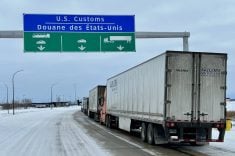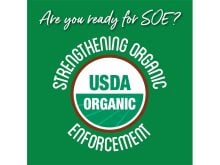Saskatchewan has tested almost one third of its share in a national goal to test 8,000 cattle for BSE in 2004.
As of Sept. 24, 550 of Saskatchewan’s 1,834 required animals had been sampled, with none testing positive for the disease.
Canadian Food Inspection Agency regional director Bill Morse said reaching that goal will be a challenge, but can be done.
“Nationally, we are just over 6,000 and the goal is 8,000. The first thing is to reach the national goal. Then it’s fine-tuning. But we’re not going to slow down. We’re one third there and the prime season (for animals to be tested) is about to start.”
Read Also

U.S. bill could keep out Canadian truckers
The Protecting America’s Roads Act, which was tabled in the U.S. House of Representatives at the beginning of October, would “rid the country of illegal immigrant commercial truck drivers and ineligible foreign nationals.”
Louise Greenberg, Saskatchewan assistant deputy minister of agriculture, said the push for testing didn’t come until late spring when most animals were on pasture. She said the province will be able to collect more samples in the fall when animals are back on the farm.
Another roadblock has been producers’ apprehension about having a positive case on their farm.
“Farmers are asking, ‘what happens if they find a positive on my farm? How am I going to be treated? What’s going to happen to the rest of the animals on my farm?’ People need to know what are the outcomes if a positive is found,” said Greenberg.
The CFIA and cattle industry associations have been holding information sessions across the country regarding an enhanced surveillance program announced last month.
Darcy Undseth, CFIA veterinary disease control specialist, told producers at a Sept. 28 information session in Saskatoon that in the event of a positive case, only animals of equivalent risk would be destroyed. Equivalent risk animals include all calves born to a BSE positive cow within two years before and after diagnosis, cattle that may have consumed the same potentially contaminated food as an affected animal, and, if feed records are untraceable, possibly herd mates born within 12 months of the infected animal.
Producers will also be compensated for animals ordered destroyed at current market value to a maximum of $2,500.
Asked whether the identity of the producer would be concealed in the event of a positive case, Undseth said the CFIA has international obligations to announce an incidence but not an owner’s identity. Laboratory data surrounding the case would be available as part of access to information, but references to the producer and farm would be removed.
While the CFIA takes measures to maintain confidentiality, Undseth said there are challenges.
“There’s likely to be a few more vehicles going to any given farm so a guy’s own neighbour is going to be wondering, and the actual producer himself may discuss it with his own neighbour just because of the action.
“It’s certainly not possible for us to guarantee it wouldn’t get out just because of all the potential people who may see increased activity at the farm or at the town if several people show up in the context with the fact that there was an international announcement that BSE was diagnosed again.”
Canada will increase its BSE testing to 30,000 animals in 2005, and Saskatchewan will have to test 6,878 as its share. Greenberg said reaching that goal will require more work and an awareness campaign.
“What CFIA and ourselves are trying to drive home is that in order for Canada to have minimal BSE status, we have to do so much testing. If we don’t do testing of these four Ds (dead, downer, diseased, distressed animals) we’re going to have to test a lot more animals that are healthy in order to meet our goals.”
With limited pickup of dead stock and only one renderer in Saskatchewan, producers will be the main source for samples.
Producers can call 866-400-4244 to report a potential sample and get more information about reimbursement.
















